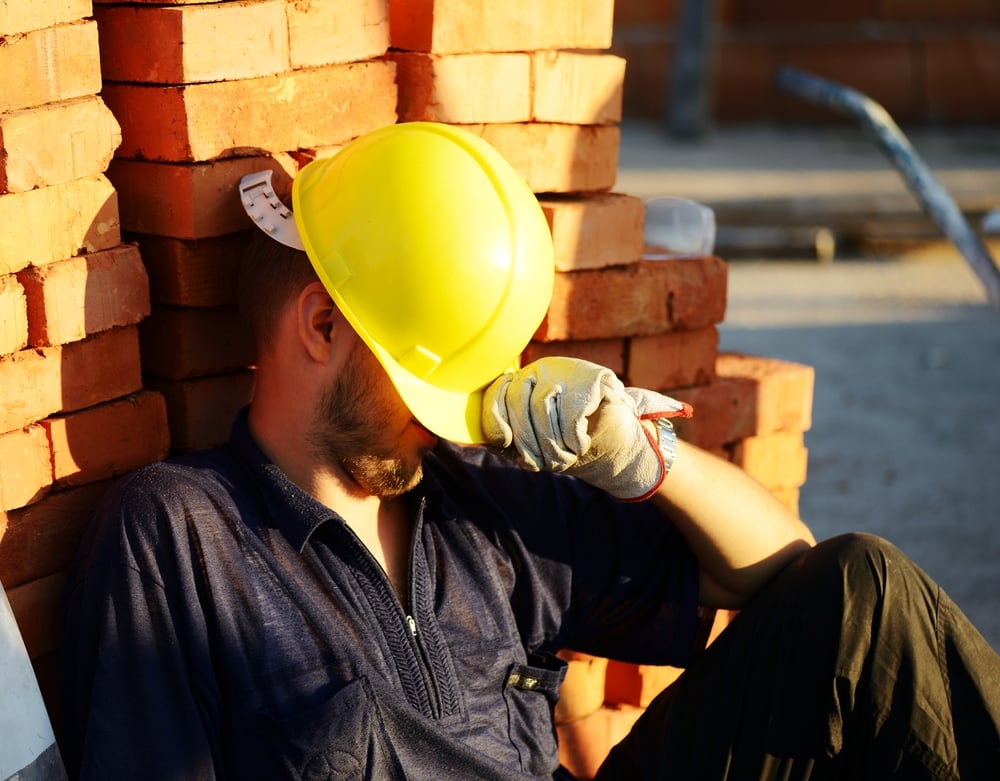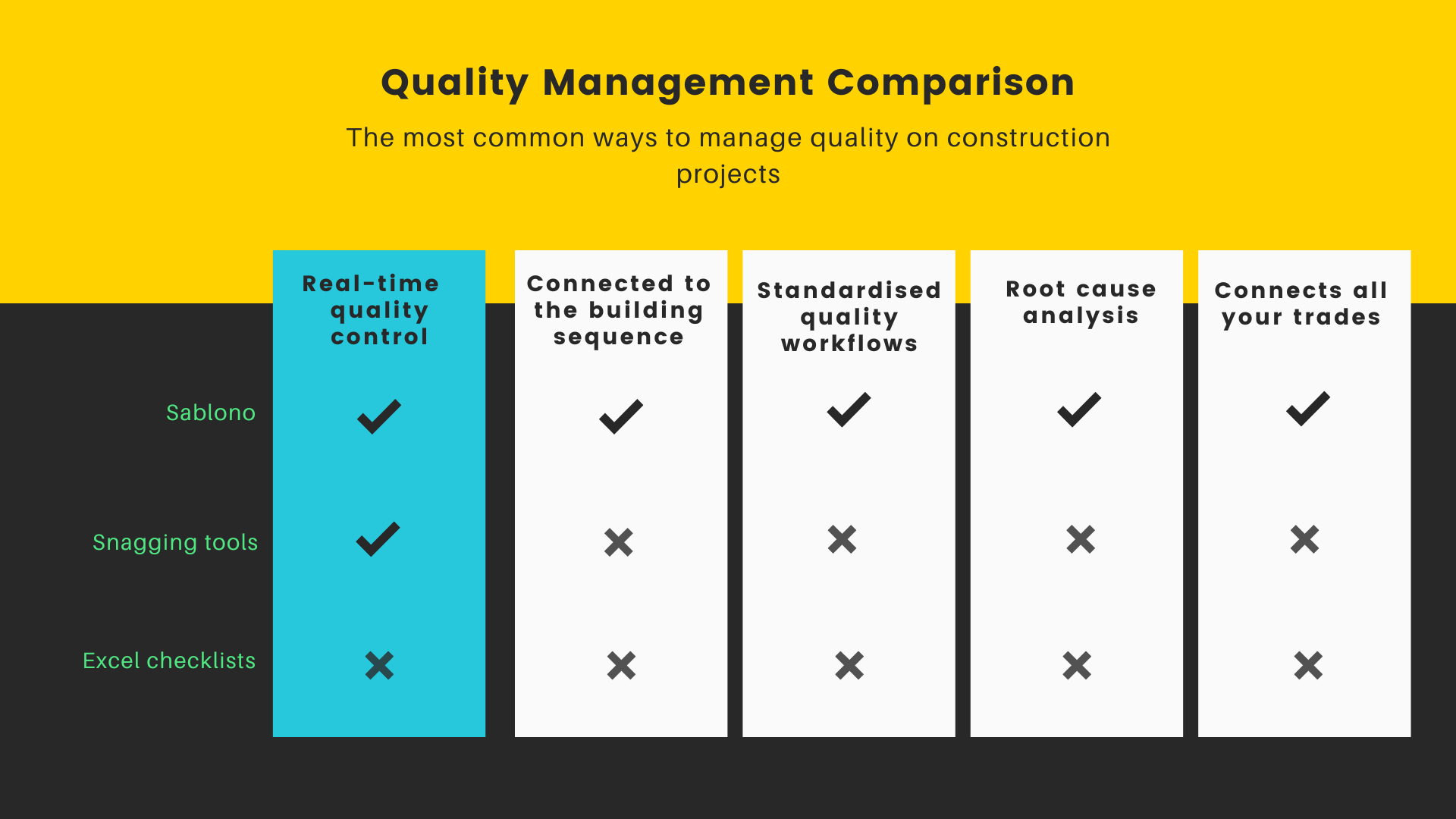By the end of this article, you'll understand the fundamentals of construction quality management including:
- What exactly is construction quality management
- 4 pillars of construction quality management
- Why quality management in construction is so important
- The biggest culprits of poor quality in construction
In addition to the practical approaches used to ensure quality in construction projects:
- Commonly used documentation in construction quality management
- The typical approaches to construction quality management
- Construction quality management best practices
We'll also debunk some commonly confused terms like:
and
What is quality management in construction?

Construction Quality Management (CQM) is an overarching discipline that involves the planning, coordination, and control of a project from inception to completion aimed at meeting a client’s requirements in order to produce a functionally and financially viable project. In essence, CQM is the route through which construction firms deliver projects that are not only up to code but also meet or exceed client satisfaction, safety standards, and sustainability benchmarks.
Quality management, with its origins in manufacturing, emphasizes customer satisfaction, continuous improvement, and the involvement of all team members in the quality process.
In construction, this translates to a focus on materials, workmanship, and the final delivery of the project. Construction quality management draws from established standards, such as ISO 9001, and tailors them to the unique challenges of construction projects, where every building is, quite literally, built from the ground up.
4 Pillars of construction quality management
Quality management in construction rests upon several key pillars:
1. Planning for quality
Before the first shovel hits the ground, a detailed quality management plan is essential. This blueprint lays out the standards, specifications, and quality objectives for the project. Effective planning means fewer surprises and a clearer understanding among all stakeholders about what defines project success.
2. Assurance and control
Quality "Assurance" involves the systematic activities implemented in a quality system so that quality requirements for a product or service will be fulfilled. This is preventive in nature. Quality "Control," on the other hand, concerns the operational techniques and activities used to fulfill quality requirements - this is corrective in nature.
3. Continuous improvement
Construction quality management is not a static process; it requires ongoing evaluation and refinement. This means incorporating feedback, learning from issues encountered, and evolving practices to ensure future projects are delivered with even higher quality.
4. Involvement of the entire team
Every worker on a construction site has a role to play in ensuring quality. From the architects to the bricklayers, an ethos of quality must permeate the team, fostering a sense of responsibility and a commitment to excellence.
Why is construction quality management so important?

Construction quality management (CQCM) is an essential component within the construction industry, ensuring that the structures we rely on daily are not only built to last but are safe, functional, and in alignment with stringent regulations and standards.
Safety and legal compliance
Safety is undoubtedly the most critical aspect of CQCM. According to the Occupational Safety and Health Administration (OSHA), one infive worker deaths in 2019 were in construction. Ensuring quality management practices are in place significantly reduces the likelihood of fatal accidents by adhering to safety protocols and performing regular inspections. Moreover, legal compliance is fundamental. CQCM ensures construction practices meet the local, state, and federal regulations, thus preventing legal issues and potential fines.
Cost savings and efficiency
Rework in construction due to poor quality can be costly. According to a report by the Construction Industry Institute, rework costs can consume nearly 5% of the total contract amount. CQCM streamlines processes, minimizing errors and defects that lead to this rework. It also optimizes resource usage, thus leading to more efficient project delivery and reduced costs.
“Poor quality can increase the cost of a building by up to more than 50% and can delay a project by up to 50%,” according to a study in Frontiers in Engineering and Built Environment.
Sustainability and environmental stewardship
Sustainability is becoming increasingly important in construction. High-quality management entails not only using materials and processes that are sustainable but also ensuring that projects are energy efficient and environmentally friendly. CQCM is instrumental in reducing waste, which in turn lessens the environmental impact of construction activities.
Client satisfaction and reputation
Delivering projects that meet or exceed client expectations is central to maintaining a construction company's reputation. A study by McKinsey & Company found that 'on-time' and 'on-budget' delivery are among the top three client concerns in construction projects. By adhering to CQCM protocols, construction companies are more likely to complete projects successfully, leading to higher satisfaction rates and repeat business.
Biggest culprits of poor quality in construction projects

In the construction industry, ensuring high-quality outcomes is not always straightforward. Various factors can compromise the quality of construction projects, leading to increased costs, delays, and customer dissatisfaction.
Understanding the root causes of poor quality is the first step toward mitigating these issues and achieving better results. Here are some of the primary contributors to subpar construction quality:
Inadequate planning and coordination
One of the fundamental issues leading to poor quality in construction projects is lack of adequate planning. This includes insufficient project detailing during the pre-construction phase, unrealistic scheduling, and poor coordination among various stakeholders. When projects are not properly planned or coordinated, misunderstandings and mistakes occur more frequently, leading to defects and rework.
Poor workmanship
The skill level and competency of the workers play a critical role in the quality of the finished product. Inadequate training, hurried work schedules, and lack of supervisory oversight often result in poor workmanship. This is particularly evident in finishes and installations, where experience and attention to detail are crucial.
Low-quality materials
Using substandard or inappropriate materials can have a severe impact on the overall quality of a construction project. This might be due to cost-cutting measures, lack of availability, or insufficient knowledge of the suitable materials for specific applications. The repercussions of using inferior materials are not only immediate in terms of aesthetic and functional defects but can also cause long-term structural issues.
Communication Failures
Effective communication among all parties involved in a construction project is essential. This includes clear conveyance of specifications, changes, and expectations between owners, contractors, designers, and subcontractors. Miscommunication can lead to errors in execution, conflicts, and non-compliance with the project’s requirements.
Lack of quality control processes
Finally, inadequate quality control mechanisms during the project lifecycle are a significant cause of poor construction quality. Without systematic monitoring and evaluation procedures, issues that could easily be fixed at an early stage may remain unaddressed until they become major complications.
Commonly confused construction quality management terms

Quality assurance (QA) vs quality control (QC)
Ensuring top-notch quality hinges on two pivotal processes: Quality Assurance (QA) and Quality Control (QC). While they are often used interchangeably, they serve distinct yet complementary roles in the construction process.
Quality Assurance is all about the proactive measures and systematic plans designed to set quality standards and prevent defects from occurring in the first place. It’s the blueprint for quality, focusing on the processes and methodologies to uphold standards throughout the project lifecycle.
In contrast, Quality Control takes a more hands-on approach, acting as the project's quality watchdog. It involves the operational techniques and activities used to fulfill quality requirements—essentially, the inspection and verification aspect of ensuring the construction meets or exceeds the set quality benchmarks.
Together, QA and QC form an interlocking framework that safeguards the integrity, safety, and excellence of construction projects, ensuring that the final outcome is not just completed, but is completed right
Quality management vs defect management
CQM is the proactive hero of our story, emphasising the importance of planning, coordination, and monitoring to ensure that quality standards are not just met but exceeded. It's about setting the bar high from the outset, ensuring every aspect of the project, from materials to workmanship, aligns with the predefined quality criteria.
On the flip side, Construction Defect Management is the reactive troubleshooter, stepping in when issues arise. This process involves identifying, documenting, and rectifying defects that occur during or after the construction process, aiming to mitigate their impact and prevent recurrence.
While Construction Quality Management seeks to avoid the need for defect management through rigorous quality protocols, Construction Defect Management acts as a safety net, ensuring that any lapses in quality are promptly and effectively addressed.
Looking for quality construction software to help you with construction quality management? We discuss the best options in this article: 'Buyer's guide to Quality Construction Software Solutions'.
Documentation used in construction quality management

To ensure that all aspects of the construction process meet the established quality benchmarks, several dedicated forms and documents are routinely employed within Construction Quality Management (CQM) systems.
Here’s an overview of the most commonly used documentation and forms that play a pivotal role in maintaining quality control and assurance throughout the lifecycle of a construction project:
Quality Management Plan (QMP)
A Quality Management Plan is a comprehensive document that specifies the quality guidelines, standards, and procedures for a construction project. It defines quality objectives, outlines project-specific quality practices, and identifies roles and responsibilities related to quality control. It serves as the roadmap for achieving the quality targets set for the project.
Inspection and Test Plans (ITP)
The Inspection and Test Plan is tailored to map out specific quality control actions and identify testing requirements for various construction activities. By setting clear criteria and procedures for inspections and testing, the ITP ensures that all construction materials and workmanship meet or exceed the required quality standards.
Non-Conformance Reports (NCR)
Non-Conformance Reports are crucial when discrepancies from established quality standards are identified. They provide a formal mechanism for documenting deviations, investigating their causes, deciding necessary corrective actions, and tracking the resolution process, thus helping in quality assurance and continuous improvement.
Quality Control Checklists
These checklists are practical tools used during various stages of construction to ensure compliance with quality specifications. They consist of detailed items that workers and supervisors check off, thereby promoting adherence to quality standards throughout the execution phase.
Material Test Reports
These reports contain results from testing performed on construction materials to verify compliance with specifications and quality standards. Material Test Reports provide essential validation that the materials used in the construction are suitable and safe for their intended purposes.
Punch Lists
As a project nears completion, punch lists are prepared to identify work that does not conform to contract specifications or requires final completion. This document is crucial for ensuring that no tasks are overlooked and that all elements of the project are completed to the required quality standards before handover.
Quality Assurance Audit Reports
Regular audits are paramount in assessing the effectiveness and adherence to a quality management system within a project. Quality Assurance Audit Reports highlight compliance, reveal discrepancies, and suggest recommendations for improving the integrity of quality management practices.
Incorporating these forms and documents in the project workflow not only helps in closely monitoring construction quality but also facilitates a structured approach to quality management, ensuring that each build phase is completed to the highest standards possible.
Typical approaches to quality management

Most companies use the following methods to manage quality on their projects:
- Excel checklists: Excel checklists are used to document any quality issues.
- Snagging tools: At the end of your project, snagging tools are used to capture and rectify any issues.
While these methods allow you to digitise quality management, they have some crucial flaws.
Relying on Excel checklists often results in a dump of unstructured information and additional time required to collect, process and make sense of this data - by which point the original data recorded is no longer up to date.
The use of snagging tools acts as a better alternative to this, but they still have their limitations. Namely, they work to simply ‘document the car crash’ instead of stopping the car crash from happening in the first place.
They tell you what has gone wrong but fail to give foresight into these quality issues and help you to understand the root cause.
Here are some of the main reasons why the traditional approaches to quality management are flawed:
- They’re not connected to your actual construction site.
- They aren’t carried out ‘in the moment’ as your project is being executed, but rather as an afterthought.
- You can’t learn from them to improve quality over time.
- They don’t foster collaboration between different parties.
In a nutshell, these approaches are reactive, not proactive - they simply document quality issues rather than working to prevent these issues from arising in the first place.
The better way to do construction quality management

So, if Excel checklists and snagging tools won’t do the job, what is the better way to do quality management on your projects?
We’ve partnered with some of the biggest contractors in the construction industry to help them get to the root of their quality issues and implement systemic change.
Below we outline the five most important best practices for construction quality management:
1. Do quality management right in the moment, not as an afterthought
There has to be a way for subcontractors on the ground to perform their own checks based on your own and external specifications and then make that information transparent and available to you immediately.
As this is happening, you want to be able to look at everything continuously at the micro and macro level.
Use a system to help you stay on top of things in real-time, instead of running to put out fires (or worse, trying to track down where the glitches are coming from).
2. Combine status management and task management with quality
Status management, task management and quality are all connected.
Taking a holistic approach that views these as parts that work together and equally have a knock-on effect on one another will allow you to manage quality far more effectively than looking at each of these parts in isolation.
This will allow you to immediately see quality issues as a task is completed so that it can be fixed sooner rather than later.
It will also enable you to understand the different factors that can play into creating quality issues in the first place so you can prevent these going forward.
3. Predefine what you want to control around quality
Set up processes and sequences you can reuse and/or adapt. Include industry standards into your predefined workflows to ensure compliance and scale your quality best practices with ease.
Be specific and clear, with each task being integrated into a workflow that your subs can check off as each job is completed. They need to know what you expect from the beginning, to cut down on closeout issues.
4. Identify quality patterns in your projects so you can learn from mistakes (root causes)
Embedding your quality management into your wider workflow will give you insights to enable you to identify the root cause of quality issues.
This is key to effective quality management as understanding the root cause of quality issues will allow you to work to prevent it from happening again.
This will help you to take a proactive approach to quality management rather than a reactive one.
5. Put collaboration at the heart of quality control
The industry has a bad reputation for the disconnect between off-site and on-site. Not only do you want to improve communication, but also that everyone can see and feel that they are collaborators in delivering a quality project.
Build a culture around the fact that they own the quality management of their piece of the puzzle.
The easiest way to better quality management
Sablono is a construction project management solution with built-in quality management that was founded on the best practice quality measures outlined above.
While digital checklists and snagging tools help to document issues, Sablono helps to prevent issues from happening in the first place. Here’s why Sablono is the best solution for construction quality management:

Integrated construction quality control and quality assurance
Take your quality management to a granular level, with digital QA’s linked to each unit.
Plan detailed workflows and attach QA checklists to each activity, then as you progress activities within Sablono, you’ll simultaneously document quality. This gives quality assurance in the moment activity, by activity.
There’s no sign-off without the sub providing all the relevant information and corresponding picture proof. This ensures tasks are completed right the first time so that you avoid issues piling up.
Understand the root cause of your quality issues
Sablono includes root cause analysis and the ability to create standardised sequences so that you can prevent making the same quality mistakes and easily scale best-practice techniques across your project.
You get insight into tendencies like particular activities that have high rejection rates, so that you can tackle those, reiterate what works, and smooth out your workflow. Sablono helps you to spot issues in advance and learn from your mistakes.
One version of the truth
Instead of just a series of fragmented feedback, everything is interconnected, and you can get a helicopter view of this “golden thread” of information running through your whole project.
Sablono combines task management, status management and quality so you can understand how all of the different parts of your project influence your plan.
Real-time, connected quality control
Sablono features real-time quality management that’s connected to your actual job site. The Sablono app can be used on the field by trades where they can report on predefined quality measures as they complete tasks.
You then get automatic notifications so you can tackle any potential problem immediately.
{Learn more about how Sablono can help streamline your quality assurance here.}
Foster collaboration and project ownership
Sablono connects all the different parties on your project and helps you to clearly define responsibilities and deadlines.
When you connect your subcontractors to the app, they can report on the status of quality and notify you immediately of any issues.
This means that everyone is responsible for managing quality on projects for greater transparency and accountability.

Conclusion: construction quality management explained
Still need help with your construction quality management process? Sablono's construction quality assurance software helps minimise defects, get to the root cause of quality issues and streamline your workflows so you can get it right first time.
Get a demo to see how Sablono can provide you with a proactive, systemic approach to construction quality management.



